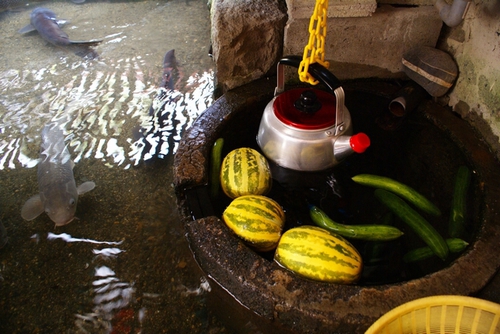December 18, 2013
Government Highlights Traditional System of Local Residents Sharing, Conserving Spring Water as Common Property
Keywords: Civil Society / Local Issues NGO / Citizen Water
 Image by wakamoana. Some Rights Reserved.
Image by wakamoana. Some Rights Reserved.
The Japanese Government's 2012 annual report on the environment (issued in June 2012) introduces a traditional system of spring water utilization, which can be seen in use by the local community in the district of Harie in Takashima City, Shiga Prefecture, as a model to sustainably share natural spring water resources. Harie is a traditional community where many households participate in a system established long ago, called "kabata."
Kabata consists of a system of three reservoirs: one called the "motoike," which stores spring water that is clean enough to be used for drinking water; the "tsuboike," which stores water used to wash vegetables and dishes; and the "hataike," which stores water in which fish are kept so that they eat food waste remaining in the water that spills from the tsuboike. The spring water, which comes up from the ground, travels from the motoike to the tsuboike, and then to the hataike, which consequently flows into a river through each house's aqueduct that connects to the outside.
For this reason, residents who use the water upstream of the river are careful not to pollute the water, out of consideration for residents downstream. This tacit rule effectively works on the basis of mutual trust in this community. From the viewpoint of sustainable use of a region's common resource, local people's efforts to continue to use a water resource in a sustainable and stable manner is considered to be one of the most basic and essential principles of conduct.
Related JFS Articles
Related
"JFS Newsletter"
- Fifth Contest to Award Excellent Environmental and Social Practices by Junior High, High School Students
- TMG Sewerage Bureau Aims to Make Tokyo a 'Smart Energy City'
- Learning from the Past: Traditional Flood Control Systems in Japan's Kofu Basin
- Yahaba Waterworks Supporters Workshop -- Citizens Decide on the Future of the Water Supply
- Arase Dam: Japan's First Dam Removal Project Underway
Related
"Popular Articles"
- Cabinet of Japan Decide to Make Full Use of Rainwater in Newly Constructed Buildings
- Japan Facing Water Shortages in Some Areas: 2010 Water Resources Report
- A Cup of Water Saving Children's Lives
- MOE Publishes Cases of Water Footprint Calculations to Visualize Water Use
- Japanese Technology to Help Address Global Water Problems


